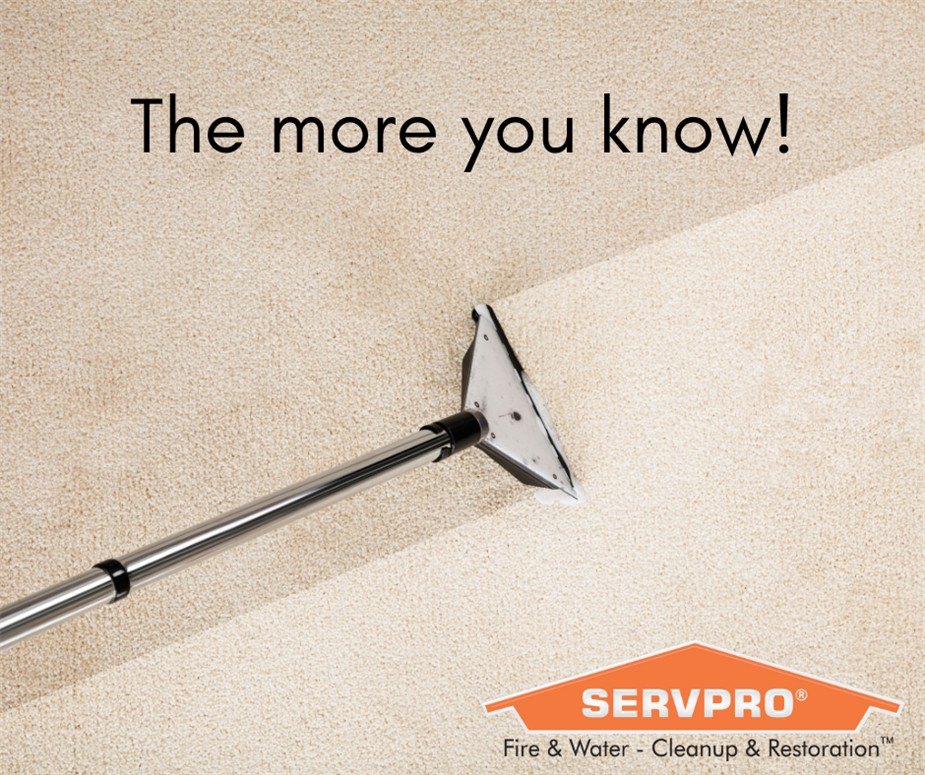Cleaning Carpets- Let's Learn Some Terms
4/6/2022 (Permalink)
Every career field has special terminology. Understanding that terminology and using them gives you credibility as professionals within your industry. Let's take a look at some of the terminology your SERVPRO professional would use when cleaning your carpets.
Absorption would be a common word used to describe some stain removal processes in carpets and textiles. This word means that liquids or gases are taken into the fabric and fibers through capillary, osmotic, or chemical reactions. An example would be the use of a towel or stain absorbing powder to move the liquid from one to the other.
Adsorption would most likely be an unfamiliar word that describes a substance being attached to the surface of the fabric or textile. An example would be applying a topical treatment such as a fire retardant or stain retardant.
Dispersion is the breaking up of solid soils so they can be separated and suspended in the cleaning solution. Another term to describe this process is deflocculation.
Surfactants are used to lower the surface tension of water-based products. It makes water "wetter"! Detergents, alcohol-based products, and heat are all surfactants.
Next time you have your carpet cleaned, you'll know the terms of the professionals!
Carpet Cleaning... Let's learn some terms!
4/6/2021 (Permalink)
Every career field has special terminology. Understanding that terminology and using them gives you credibility as professionals within your industry. Let's take a look at some of the terminology your SERVPRO professional would use when cleaning your carpets.
Absorption would be a common word used to describe some stain removal processes in carpets and textiles. This word means that liquids or gases are taken into the fabric and fibers through capillary, osmotic, or chemical reactions. An example would be the use of a towel or stain absorbing powder to move the liquid from one to the other.
Adsorption would most likely be an unfamiliar word that describes a substance being attached to the surface of the fabric or textile. An example would be applying a topical treatment such as a fire retardant or stain retardant.
Dispersion is the breaking up of solid soils so they can be separated and suspended in the cleaning solution. Another term to describe this process is deflocculation.
Surfactants are used to lower the surface tension of water-based products. It makes water "wetter"! Detergents, alcohol-based products, and heat are all surfactants.
Next time you have your carpet cleaned, you'll know the terms of the professionals!
How to Clean and Disinfect Your Home
4/20/2020 (Permalink)
Disinfecting Your Home
April, 20th, 2020
What Disinfectant to Use and How to Use It?
With the ongoing spread of COVID-19, the issue has caused concern for the manner in which Americans behave in terms of cleanliness. How long do we wash our hands? Do we use warm water and soap, or does cold water have the same effect? Is Lysol better than a multipurpose cleaner? What you may be surprised to know is that many are using the right disinfectant incorrectly. Many of us simply take Lysol for instance, spray a surface and immediately wipe it dry. This is entirely the wrong way to use the disinfectant. According to the Environmental Protection Agency (EPA) and the Center’s for Disease Control (CDC), the dwell time in which a chemical (Lysol for instance) ranges from thirty seconds, to upwards of ten minutes depending upon the bacteria or virus you are looking to minimize exposure to. That list of household disinfectants is available by clicking HERE. If the link does not work, refer to the full reference listed at the conclusion of this blog.
Where do I need to Focus?
According to the CDC, high touch areas in the home are of primary concern when it comes to routine cleaning/disinfecting. High touch areas include but are not limited to; tables, doorknobs, light switches, toilets/handles, desks, phones, keyboards, faucets, sinks, etc. Be careful when cleaning soft surfaces and electronics. Make sure to consult the instructions on the product prior to using it on each different type of surface, and consulting with the EPA’s Registered Household Disinfectant Guide to see how long the disinfectant should remain on the surface before wiping it dry.
Always make sure to use proper Personal Protective Equipment (PPE) when using household or other chemical disinfectants. Generally, standard rubber gloves will be sufficient, and it is always recommended to wash your hands in warm soapy water for no less than 20 seconds once cleaning has been concluded and cleaning chemicals have been properly stored away from the reach of young children. You can view other cleaning recommendations by visiting HERE. If the link does not work, you can review the full link provided in the list of references below.
References:
Center's for Disease Control (CDC). (2020, April 20). Cleaning And Disinfecting Your Home. Retrieved from Center's for Disease Control : https://www.cdc.gov/coronavirus/2019-ncov/prevent-getting-sick/disinfecting-your-home.html
United States Environmental Protection Agency. (2020, April 20th). List N: Disinfectants for Use Against SARS-CoV-2. Retrieved from United States Environmental Protection Agency: https://www.epa.gov/pesticide-registration/list-n-disinfectants-use-against-sars-cov-2



 24/7 Emergency Service
24/7 Emergency Service
